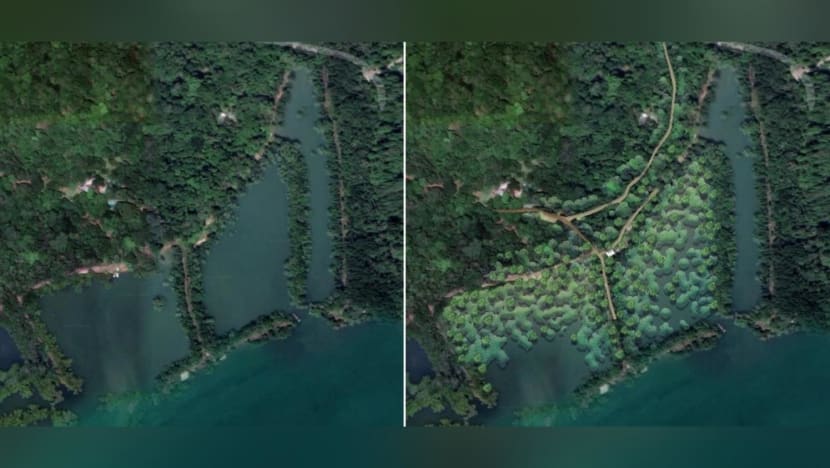Mangrove park with about 8,000 trees to open in Pulau Ubin in 2026

In its current condition (left), mangroves have been observed to regenerate at the Sungei Durian ponds near the bunds and in shallower areas. Digital rendering shows how the site will look 10 years later (right). (Images: National Parks Board)
SINGAPORE: The National Parks Board (NParks) and OCBC Bank unveiled plans on Saturday (Oct 29) for 8,000 mangrove plants to "naturally take root" at a site in Pulau Ubin that is currently filled with abandoned aquaculture ponds.
Located at Sungei Durian in Pulau Ubin, the OCBC Mangrove Park will be Singapore's first large-scale project to adopt the Ecological Mangrove Restoration method, NParks and OCBC said in a joint news release.
Work is estimated to be completed by 2026 and community engagement and outreach programmes will be introduced following the park's opening that year, providing additional recreational opportunities for members of the public.
Besides the mangrove plants, OCBC said it will work with staff volunteers and the community, including the Friends of Ubin Network, to plant an additional 1,000 mangrove saplings across the island over the next six years, including at Sungei Puaka and Sungei Jelutong ponds.
Some native mangrove tree species that will be planted include the Bakau Minyak, Black Mangrove and the Pakau Putih.
"Collectively, the 9,000 mangrove trees could potentially sequester up to 30 million kg of carbon dioxide in their lifetimes.
"Together with the surrounding mudflats and soils, the amount of carbon stored in a mangrove ecosystem could be three to four times more than in a terrestrial ecosystem," said NParks and OCBC.
The project was launched by Minister for National Development Desmond Lee, Group CEO of OCBC Bank Helen Wong, Chairman of Garden City Fund Professor Leo Tan and CEO of NParks Kenneth Er.
Mr Lee said the new mangrove park will help restore and safeguard more of the mangrove patches in Singapore and complements other nature-based solutions implemented by NParks including a coastal protection and mangrove restoration project at Pulau Tekong and the creation of a coastal belt at Kranji Coastal Nature Park.
"These solutions are important in mitigating climate change and offer additional habitats for our native biodiversity," he added.
ECOLOGICAL MANGROVE RESTORATION METHOD
Led by NParks, the mangrove park uses the Ecological Mangrove Restoration method, which is a science-based approach that facilitates the natural establishment of mangrove plants.
It aims to produce a self-sustaining ecosystem where minimal human intervention will be needed to allow the mangroves to propagate, said NParks and OCBC.
The method was first recommended for use at the Sungei Durian ponds by the Restore Ubin Mangroves initiative.
Spanning about 4 hectares and located at the Sungei Durian ponds along the southern coast of Pulau Ubin, the mangrove restoration site used to be filled with natural mangroves.
However, the natural mangroves were mostly cleared and converted into aquaculture ponds in the 1990s to facilitate farming activities. The ponds were then abandoned in 2001.
Upcoming works include earth-filling to increase the elevation levels of the pond beds, adding drain culverts to increase water and sediment flow to the ponds, as well as erecting gabion blocks to prevent sediment from flowing out to the sea.
According to NParks, the Ecological Mangrove Restoration method has been widely adopted in many countries.
Successful case studies included a community-based restoration on Tanakeke island in South Sulawesi, Indonesia. Restoring the natural mangrove ecosystem benefitted the local fishing community, such as greater storm protection and availability of non-timber forest products for local markets.
Singapore is home to more than 30 mangrove tree species, including the Crabapple Mangrove, the Gedabu and the Api-api Jambu.
Its current supply of mangrove trees sequester more than 1.4 million tonnes of carbon dioxide and continue to store more carbon every year.
Besides removing carbon and storing it, some mangroves in Singapore can absorb more than 75 per cent of the energy of incoming waves and protect the shorelines during storm surges.
This helps to protect communities from threats associated with climate change, including worsening storms, rising sea levels and erosion.


















